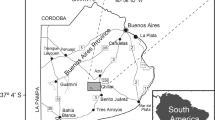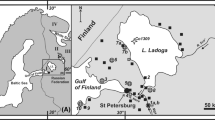Abstract
Three cores from two connected lakes in Central Ireland (Lough Kinale and Derragh Lough) were investigated using diatom analysis to establish the Holocene development of the lacustrine system, any local variations within the lakes and any anthropogenic influences. The study area was situated in a lowland location and the lakes were shallow, unstratified and interconnected. Litho-and bio-stratigraphical analyses of the lake cores and deposits beneath a mire separating the two lakes showed the changing spatial configuration of the lake system in the early Holocene and the separation of the initial lake into three basins (cf. lacustrine cells) and finally into two interlinked lakes. The evolution of the lake system is conceptualised as the development of distinct lacustrine cells, and its sediments have recorded changes in the physical (geography, depth and sedimentation) and chemical (water chemistry) properties of the lakes inferred through diatom analyses. The longest sequence, from the early Holocene, records fluctuating lake levels and these are correlated with geomorphological mapping and surveying of palaeoshorelines. The diatom assemblages of the upper 2 m of the three cores, covering approximately the last 2000–3000 radiocarbon years show considerable difference in trophic status and life-form categories. This is related to the location of the cores in the lake and also the distance from human settlement with particular reference to proximity to crannog (artificial island) construction and use. The most central core from the deepest part of Lough Kinale has the least representation of the human settlement and agricultural activity in the catchment and on the fringes of the lake, whereas the core taken from the edge of a crannog is able to identify when construction and use of the crannog occurred. The local nature of the palaeoecological response to human activity due to incomplete water mixing has the advantage of allowing the lake sediment cores to be used to determine spatially discrete settlement patterns.









Similar content being viewed by others
References
Aaby B, Berglund BE (1986) The characterisation of peat and lake deposits. In: Berglund BE (ed) Handbook of Holocene palaeoecology and palaeohydrology. Wiley, Chichester, pp 231–246
Amsinck SL, Jeppesen E, Landkildehus F (2005) Relationships between environmental variables and zooplankton subfossils in the surface sediments of 36 shallow coastal brackish lakes with special emphasis on the role of fish. J Paleolimnol 33:39–51
Amoros C, Roux AL, Regrobellet JL, Bravard JP, Pautou G (1987) A method for applied ecological studies of fluvial hydrosystems. Reg Riv 1:17–36
Anderson NJ (1986) Diatom biostratigraphy and comparative core correlation within a small lake basin. Hydrobiologia 143:105–112
Anderson NJ (1990) Variability of diatom concentration and accumulation rates in sediments of a small lake basin. Limnol Oceanog 35:497–508
Anderson NJ (1994) Comparative planktonic diatom biomass responses to lake and catchment disturbance. J Plankt Res 16:133–150
Anderson NJ (1997) Historical changes in epilimnetic phosphorous concentrations in six rural lakes in Northern Ireland. Freshw Biol 38:427–440
Anderson NJ (1998) Variability of diatom-inferred phosphorus profiles in a small lake basin and its implications for histories of lake eutrophication. J Paleolimnol 20:47–55
Anderson NJ, Battarbee RW (1992) Aquatic community persistency and variability: a palaeolimnological persepective. In: Giller PS, Hildrew AG, Raffaelli DG (eds) Aquatic ecology, scale, pattern and process. Blackwell Scientific Publications, Oxford, pp 233–259
Battarbee RW (1986) Diatom analysis. In: Berglund BE (ed) Handbook of Holocene palaeoecology and palaeohydrology. Wiley, Chichester, Chapter 26, pp 527–570
Battarbee RW (2000) Palaeolimnological approaches to climate change, with special regard to the biological record. Quat Sci Rev 19:107–124
Bennion H, Appleby PG, Phillips GL (2001) Reconstructing nutrient histories in the Norfolk Broads, UK: implications for the role of diatom-total phosphorus transfer functions in shallow lake management. J Paleolimnol 26:181–204
Berglund BE (ed) (1986) Handbook of Holocene palaeoecology and palaeohydrology. Chichester, John Wiley and Sons
Brown AG (2002) Learning from the Past: Palaeohydrology and Palaeoecology. Freshw Biol 47:817–830
Brown AG, Hatton J, O’Brien CE, Selby KA, Langdon PG, Stuijts I, Caseldine CJ (2005) Vegetation, landscape and human activity in Midland Ireland: mire and lake records from the Lough Kinale-Derragh Lough area, Central Ireland Veg. Hist and Archaeobot 14:81–98
Canadian Diatom Database. Geological Society of Canada. http://gsc.nrcan.gc.ca/paleo/diatoms/indexe.php, accessed March 6, 2006
Carter RWG (1988) Coastal environments. Academic Press, London
Chambers JW, Cameron NG (2001) A rod-less piston-corer for lake sediments: an improved, rope operated hammer corer. J Paleolimnol 25:117–122
Champ T (1993) Lough Sheelin; a success story. In: Mollan C (ed) Water of life. Royal Society Dublin, Dublin, pp 154–162
Cohen AS (2003) Paleolimnology. Oxford University Press, Oxford
Collins AEP (1955) Excavations at Lough Faughan crannog, Co. Down, 1950–51. Ulster J Archaeol 18:5–82
Crone BA (2002) The history of a Scottish Lowland Crannog: excavations at Buiston, Ayreshire 1989–90. Monograph 4, Edinburgh
Denys L (1991/1992) A check-list of the diatoms in the Holocene coastal deposits of the Western Belgian Coastal plain with a survey of their apparent ecological requirements. 1. Introduction, ecological code and complete list. Professional Paper No. 246. Ministere des Affaires Economiques. Service Geologique de Belgique
Edwards KJ, Whittington G (2001) Lake sediments, erosion and landscape change during the Holocene in Britain and Ireland. Catena 42:143–173
European Diatom Database. Newcastle University, http://craticula.ncl.ac.uk/Eddi/jsp/index.jsp
Fredengren C (2002) Crannogs. Wordwell, Co Wicklow
Germain H (1981) Flore des Diatomées Diatomophycées. Societe nouvelle des editions boubée, Paris
Gibson CE, Anderson NJ, Zhou Q, Allen M, Appleby PG (2003) Changes in sediment and diatom deposition in Lower Lough Erne c. 1920–1960. Proc R IrAcad 103B:1–39
Grimm EC (1987) CONISS: a FORTRAN 77 program for stratigraphically constrained cluster analysis by the method of incremental sum of squares. Comput Geosci 13:13–35
Grimm EC (1991) Tilia version 2.0b4 and Tilia*graph 2.0b5. Program for the analysis and display of microfossil data. Illinois State Museum, Springfield, Illinois
Hencken HO (1950) Lagore crannog: an Irish Royal residence of the seventh to tenth century AD. Proc R Ir Acad 53C:1–248
Horne AJ, Goldman CR (1994) Limnology Second. McGraw-Hill, New York, p 576
Irish Meteorological Service (Website) (2004) http://www.met.ie/climate/, accessed October 20, 2004
Jowsey PC (1966) An improved peat sampler. New Phytol 65:245–248
Kelts K, Hsu KJ (1978) Freshwater carbonate sedimentation. In: Lerman A (ed) Lakes: chemistry, geology and physics. Springer-Verlag, New York, pp 295–323
Krammer K, Lange-Bertalot H (1986–1991) Bacillariophycea, 1–4. Teil. In: Gustav Fischer Verlag VEB (ed) Süßwasserflora von Mitteleuropa, 1991, Stuttgart, p 437
Lane SN, Richards KS (1997) Linking river channel form and process: time, space and causality revisited. Earth Surface Procs. Landforms 22:249–260
Last WM, Smol JP (eds) (2001) Tracking environmental change using lake sediments. Kluwer
Marchetto A, Mosello R, Rogora M, Manca M, Boggero A, Morabitop G, Musazzi S, Tartari GA, Nocentini AM, Pugnettii A, Bettinetti R, Panzani P, Armiraglio M, Cammarano P, Lami A (2004) The chemical and biological response of two remote mountain lakes in the Southern Central Alps (Italy) to twenty years of changing physical and chemical Climate. J Limnol 63:77–89
Norrman JO (1964) Lake Vättern. Investigations on shore and bottom morphology. Geog Annaler 46:1–238
Oldfield F (1977) Lakes and their drainage basins as units of sediment based ecological study. Prog Phys Geog 1:460–504
O’Brien C, Selby KA, Brown AG, Ruiz Z, Caseldine CJ (2005) A Multi-proxy environmental approach to the archaeological investigation of Crannogs. Holocene 15:707–719
Patrick R, Reimer CW (1966, 1975) The Diatoms of the United States. Exclusive of Alaska and Hawaii, vol 1 and 2. Monographic series of Academy of Natural Sciences of Philadelphia #13, Pennsylvannia
Perren BB, Bradley RS, Francus P (2003) Rapid lacustrine response to recent high arctic warming: from Sawtooth Lake, Ellesmere Island, Nunavut. Arct Antarct Alp Res 35:271–278
Phillips BAM (1980) The Great Lakes In: McCann SB (ed) Coastlines of Canada, Memoir 80–10. Geological Survey of Canada, Ottawa, pp 407–415
Raftery B (1957) The lake dwellings of Ireland. Scientific Service 4:5–15
Redknapp M (1994) The early medieval crannog at Llangorse, Powys: an interim statement on the 1989–1993 seasons. Int J Naut Archaeol 23:189–205
Round RE, Crawford RM, Mann DG (1990) The Diatoms—biology & morphology of the genera. Cambridge University Press
Rühland KM, Smol JP, Pienitz R (2003) Ecology and spatial distributions of surface-sediment diatoms from 77 lakes in the subarctic Canadian treeline region. Can J Bot 81:57–73
Sands R, Hale A (2001) Evidence from marine crannogs of later prehistoric use of the Firth of Clyde. J Wetland Archaeol 1:41–54
Selby KA, O’Brien CE, Brown AG, Ruiz Z, Stuijts I, Langdon PG, Caseldine CJ (2004) An environmental investigation in the Lough Kinale–Derragh Lough Area. Report for the Irish Discovery Programme Lake Settlements Project, University of Exeter
Selby KA, O’Brien CE, Brown AG (2005) A multi-proxy study of Holocene lake development, lake settlement and vegetation history in central Ireland. J Quat Sci 20:147–168
Sevastopulo GD, Wyse Jackson PN (2001) Carboniferous (Dinantian). In: Holland CH (ed) The geology of Ireland. Dunedin Academic Press, Edinburgh, pp 241–288
Smol JP (2002) Pollution of lakes and rivers: a paleoenvironmental perspective. Arnold, London
Stuiver M, Reimer PJ, Bard E, Beck JW, Burr GS, Hughen KA, Kromer B, McCormac, FG, v.d. Plicht J, Spurk M (1998) Calib 4.3 Radiocarbon 40:1041–1083
Treese KL, Wilkinson BH (1982) Peat-marl deposition in a Holocene paludal-lacustrine basin-Sucker Lake, Michigan. Sedimentology 29:375–390
Tylmann W (2005) Lithological and geochemical record of anthropogenic changes in recent sediments of a small and shallow lake (Lake Pusty Staw, northern Poland). J Paleolimnol 33:313–325
Willen E, Hajdu S, Pejler Y (1990) Summer phytoplankton in 73 nutrient-poor Swedish lakes. Classification, ordination and choice of long-term monitoring objects. Limnologica 21:217–227
Zolitschka B, Behre K-E, Schneider J (2003) Human and climatic impact on the environment as derived from colluvial, fluvial and lacustrine archives—examples from the Bronze Age to the Migration period, Germany. Quat Sci Revs 22:81–100
Acknowledgements
The work described in this paper formed part of research commissioned by The Discovery Programme (Ireland) as part of their Lake Settlements Project. The authors must thank many others for assistance with this research; C. O’Brien, C. Caseldine, I. Stuijts, C. Fredengren, P. Langdon and Z. Ruiz. Funding and field assistance was provided by the Irish Discovery Lake Settlements Project. S. Rouillard is thanked for drawing the figures. Thanks are also due to the in-depth comments of F. J. G. Mitchell, V. Hall, J. Anderson and the anonymous referees for their helpful comments.
Author information
Authors and Affiliations
Corresponding author
Rights and permissions
About this article
Cite this article
Selby, K.A., Brown, A.G. Holocene development and anthropogenic disturbance of a shallow lake system in Central Ireland recorded by diatoms. J Paleolimnol 38, 419–440 (2007). https://doi.org/10.1007/s10933-006-9081-y
Received:
Accepted:
Published:
Issue Date:
DOI: https://doi.org/10.1007/s10933-006-9081-y




